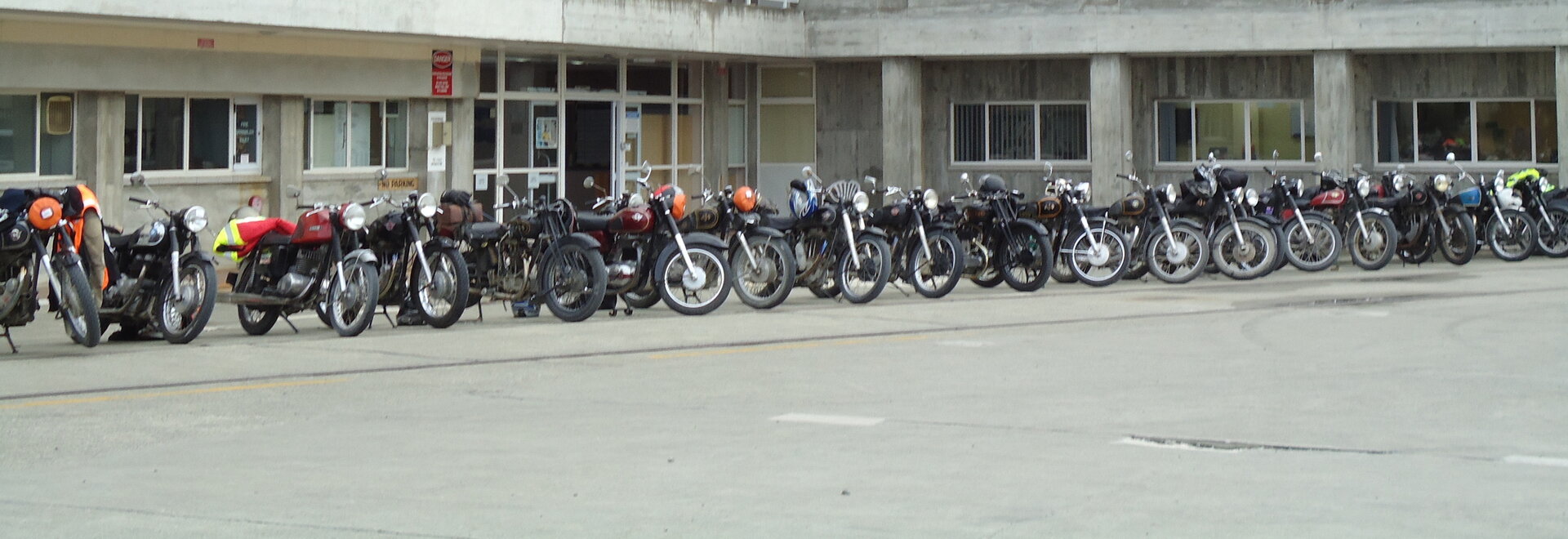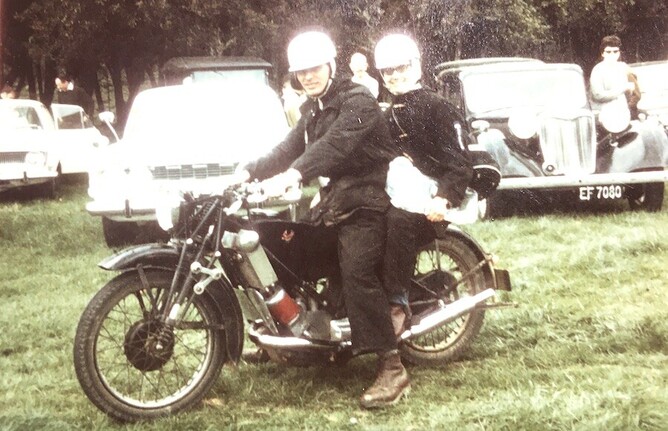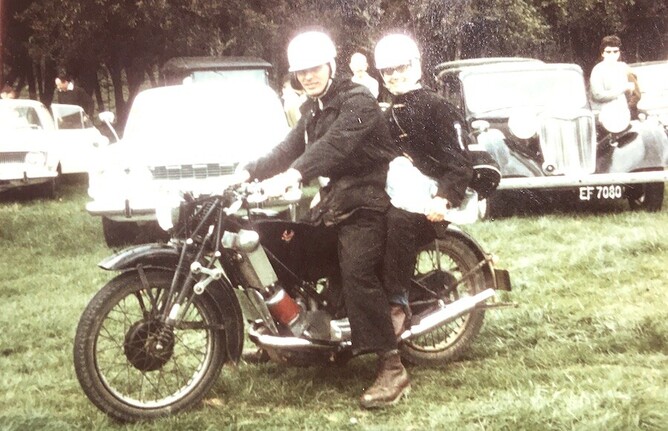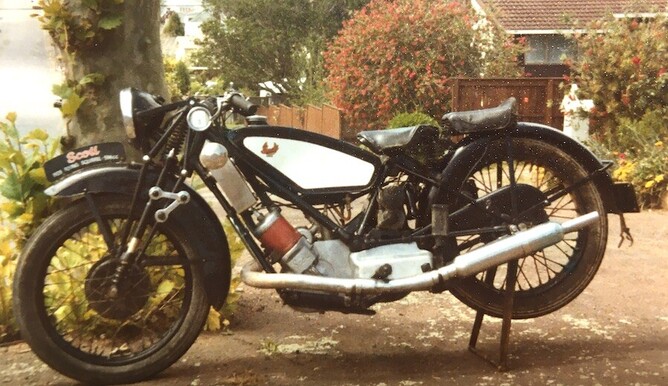When booking accommodation for the (cancelled) 2022 rally at Clarks Beach the owner Robyn Pearce, mentioned that “As a young woman I travelled many miles pillion on a 1928 Scott Flying Squirrel…”.
When cancelling the accommodation I took a punt to ask if she would like to write an article about her adventures. The result was:
The ‘hard’ adventures of pillion riding on a 1928 Scott Flying Squirrel
By Robyn Pearce
More years ago than seems possible, my new BF (boyfriend) rocked up to visit, proudly riding a noisy beast. Billowing clouds of oily smoke streamed out of the exhaust pipe and the motor had a deep, throaty burbling sound unlike any other bike I’d ever heard. No-one in our farming community had a vintage bike, let alone something as rare as this black beauty―a 1928 Scott Flying Squirrel 596 cc water-cooled 2-stroke. (3-speed with hand gear change for those who want more technical data.)
BF loved that bike! He regaled my family with stories of how people thought the Japanese had invented water-cooled 2-strokes, but how wrong they were. He informed us of the marvels of pioneer English engineers and the beautiful machinery they made. We heard full details of the Scott’s torque ratios, the construction of the engine, her speed (was she a female because she was contrary? I never did find out). We got the pedigree of this particular bike, and more.
To me, an impressionable teenager, that such an old machine could travel up to 70 m.p.h. was awesome. It’s not recorded what my gentle father thought of his daughter travelling pillion at that speed on such an ancient machine. I look back now and don’t think I’d have been keen to let my 17-year-old daughter disappear in clouds of smoke on such a steed.
BF never gave me the opportunity to take the controls, and I didn’t want to; she was a heavy old girl, and the kick-start was difficult. No, my place was behind. He quickly inducted me into the right way to ride pillion―not clinging to the rider, but holding on to the underneath of the seat. I rode many miles on the back of that old girl. And I must mention a VERY IMPORTANT detail. The rear seat had no shock absorbers, or springs, or any significant padding. It was just hard, thin leather. So, I absorbed every bump, every pot-hole. I was the shock absorber.
Was it reliable? Actually—here’s the heretical statement—no! I quickly learnt to always carry a time-filler. Many hours were spent sitting on roadsides with my head in a book while he blew on spark plugs, adjusted tappets, and threw out comments about clearances and dirty oil.
Although the Scott was fast in comparison with almost anything else of her age, any speed advantage disappeared whenever we pulled in for petrol and oil. At anything but the most remote petrol station, within moments of pulling up, a ring of curious men and boys would surround the bike and owner. Few had ever seen such an unusual machine. Then BF was in his element. Fifteen to twenty minutes could easily vanish in technical discussion while I waited patiently (mostly).
The BF became an H (husband), and for the next three years the Scott was treated like our baby. From time to time parts would dominate the kitchen table, and he spent hours tinkering lovingly with her innards.
A couple of memorable trips, from the perspective of pillion riding, stand out. Try going over the Kaimais to Tauranga, on what seemed like about 30 miles of rough corrugated gravel. I can’t remember now whether they were still sealing the road, or whether it was road-works, but the corrugations were interminable. (It would have been around 1968 or 69.) What I do remember is my excruciating back by the time we reached our kindly hosts. We were in Tauranga for a vintage car and bike rally.
Another time, H decided a trip to New Plymouth was in order, starting from our home just south of Te Awamutu. Rain was forecast, so we dressed in our best wet-weather gear. H had his farming waterproofs, I had similar but lesser quality gear, and our helmets were nearly as old as the bike. Think German helmets of World War II and you’re not far off. Pudding bowls could be another descriptor. By the time we reached Te Kuiti, the rain had set in. Moisture quickly ran down my back, then my front. By the time we got to Pio Pio, I was wet through. By the time we reached our destination, I was so frozen I had to be peeled off the bike and put in a hot bath, borderline hypothermic.
(Years later, riding pillion through rain on a modern sports bike with my oldest son from Wellington to Auckland, but this time clad in the light but beautifully water-proof gear the Army kindly provide their soldiers, and with a decent full-face helmet, I finally realised the joy of keeping warm and dry on a bike―if you’ve got the right gear!)
They were fun years. We met many wonderful people through the Vintage Car and Bike movement, and took part in rallies every year until the first of six children arrived.
The bike is still in the family—not running at present, but safe and secure in the shed of one of those children.
Here’s a more technical description of a Scott ride. https://www.motorcycleclassics.com/classic-british-motorcycles/1927-scott-flying-squirrel-zv0z1405zbea/
About the author: Robyn Pearce seldom rides motorbikes now, for lack of opportunity, not ability. She’s always up for a challenge and admires beautiful craftmanship of any sort. These days she gets her fix for old things as a crew member on WAITANGI, a beautiful 1894 gaff-rigged cutter, one of the Auckland Classic Yacht fleet. (Not as noisy as the Scott, sometimes as wet, and as much fun.) She’s also a writer of both historical fiction and non-fiction. https://www.robynpearce.com



